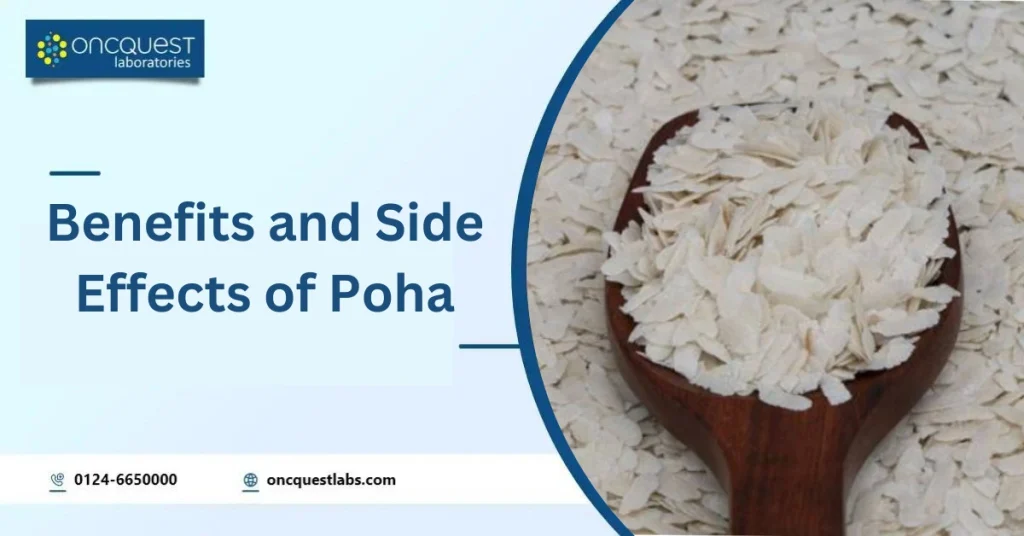Poha is a traditional Indian dish made from flattened rice. It’s a popular breakfast option in many parts of India and holds cultural significance. The word “poha” itself refers to the flattened rice flakes used to make the dish. Poha is known for its simplicity, quick preparation, and versatility in flavorings, making it a favorite among both home cooks and professional chefs.
Contents
Where does it Come from?
Poha originates from India, particularly from the western regions like Maharashtra and Gujarat. It has been a staple food in Indian cuisine for centuries and is believed to have originated in these regions before spreading to other parts of the country. The process of flattening rice to make poha is thought to have been developed in these areas, where rice is a primary crop, as a way to preserve and utilize rice grains more efficiently. Today, poha is enjoyed not only across India but also in various other countries where Indian cuisine is popular.
Nutritional Value of Poha:
| Nutrient | Amount per 100g |
| Calories | 345 kcal |
| Carbohydrates | 76 g |
| Protein | 6 g |
| Fat | 1 g |
| Fiber | 2 g |
| Iron | 5 mg |
| Vitamin C | 0 mg |
| Calcium | 25 mg |
| Sodium | 1 mg |
7 Health Benefits of Poha
1. Energy Boost
Poha serves as an excellent source of carbohydrates, which are the body’s primary source of energy. The carbohydrates in poha are digested and absorbed relatively quickly, providing a rapid boost of energy. This makes poha an ideal choice for breakfast or snacks, especially for individuals needing a quick energy boost to start their day or refuel after physical activity.
2. Nutrient-Rich
Poha is not only rich in carbohydrates but also contains essential nutrients such as iron, vitamins, and minerals. Iron is crucial for the production of hemoglobin, which carries oxygen in the blood, while vitamins and minerals support various bodily functions, including immune function, metabolism, and cell repair. Incorporating nutrient-rich foods like poha into your diet can help ensure you meet your daily nutritional requirements.
3. Digestive Health
Poha is a good source of dietary fiber, which plays a vital role in promoting digestive health. Fiber adds bulk to stool, helping to prevent constipation and promote regular bowel movements. Additionally, fiber acts as a prebiotic, feeding beneficial bacteria in the gut, which contribute to overall gut health and may reduce the risk of digestive disorders such as irritable bowel syndrome (IBS) and diverticulitis.
4. Gluten-Free
Poha is naturally gluten-free, making it a safe and nutritious option for individuals with gluten intolerance or celiac disease. Gluten is a protein found in wheat, barley, and rye, and consuming gluten-containing foods can trigger adverse reactions in individuals with gluten-related disorders. Poha provides a gluten-free alternative that allows individuals with gluten intolerance to enjoy a delicious and nutritious meal without compromising their health.
5. Versatile
Poha’s versatility makes it a popular choice in various cuisines and culinary traditions. It can be easily customized with a wide range of ingredients, including vegetables, herbs, spices, and protein sources like eggs or tofu. This versatility allows for diverse flavor combinations and nutritional profiles, making poha suitable for individuals with different dietary preferences and restrictions. Whether sweet or savory, spicy or mild, poha can be tailored to suit individual tastes and preferences.
6. Low in Calories
Despite its carbohydrate content, poha is relatively low in calories, making it a suitable option for individuals looking to manage their calorie intake or lose weight. By providing satiety and satisfaction without excessive calorie consumption, poha can help support weight management efforts when incorporated into a balanced diet and healthy lifestyle. Additionally, the low-calorie content of poha makes it a guilt-free option for individuals craving a satisfying and nutritious meal or snack.
7. Cultural Significance:
Beyond its nutritional benefits, poha holds cultural significance in Indian cuisine and is often enjoyed as a traditional breakfast dish in many households. It is associated with comfort, nostalgia, and communal eating experiences, connecting people to their culinary heritage and cultural identity. Incorporating poha into your diet not only provides health benefits but also fosters a sense of belonging and cultural appreciation, making it a meaningful addition to any mealtime experience.
Side-Effects of Poha
High Glycemic Index: Poha has a high glycemic index, which means it can cause a rapid increase in blood sugar levels. This may not be suitable for individuals with diabetes or those trying to manage their blood sugar levels.
Overconsumption: Eating too much poha regularly can lead to excessive calorie intake, which may contribute to weight gain over time. Portion control is essential, especially if you’re watching your calorie intake.
Allergic Reactions: Some individuals may be allergic to certain ingredients commonly used in poha, such as peanuts or spices. It’s important to be cautious and aware of any potential allergens when preparing or consuming poha.
Impact on Blood Sugar Levels: Due to its high carbohydrate content, consuming poha in large quantities can cause a spike in blood sugar levels, followed by a crash. This can lead to feelings of fatigue and hunger shortly after eating.
How to Cook and Eat Poha
Poha, also known as flattened rice or beaten rice, is a popular Indian breakfast dish that is both delicious and nutritious. Here’s how to prepare and enjoy this flavorful dish:
Cooking and Enjoying Poha is a Simple process:
Preparation: Begin by rinsing the poha flakes in water to remove any dust or impurities. Drain them thoroughly and set aside.
Tempering: Heat oil in a pan and add mustard seeds, cumin seeds, and curry leaves for tempering. You can also add chopped onions, green chilies, and peanuts for added flavor.
Adding Poha: Once the tempering is ready, add the drained poha flakes to the pan. Stir gently to combine and ensure that the poha is evenly coated with the tempering.
Seasoning: Sprinkle salt, turmeric powder, and sugar over the poha mixture. You can also squeeze some lemon juice for a tangy flavor.
Mixing: Mix everything well and cook for a few minutes until the poha is heated through and the flavors are well blended.
Garnishing: Garnish with freshly chopped coriander leaves and grated coconut for added freshness and flavor.
Serving: Serve hot poha with a side of freshly sliced lemon or enjoy it with a dollop of yogurt or chutney for a complete meal
Poha can also be enjoyed with various toppings such as sev, roasted peanuts, or grated cheese, depending on personal preference. Experiment with different ingredients to create your own unique version of this classic dish!
Clearing Up Confusion:
There are often misconceptions surrounding poha. Let’s address some of them:
Poha vs. Flattened Rice: Poha and flattened rice are often used interchangeably, but they are not exactly the same. Poha refers specifically to flattened rice that has been processed and flattened, while flattened rice is a broader term that may include different types of flattened grains.
Nutritional Myths: There are various myths surrounding the nutritional value of poha, with some claiming it to be unhealthy due to its carbohydrate content. However, when consumed in moderation and as part of a balanced diet, poha can be a nutritious and satisfying meal option.
By clarifying these misconceptions, we can better understand the true nature and benefits of poha as a wholesome food choice.
Is Poha Good for Weight Loss?
Poha can be a beneficial addition to a weight-loss diet when consumed in moderation and as part of a balanced meal plan. Here’s a deeper explanation of why poha can be good for weight loss:
Low in Calories and Fat: One of the main reasons why poha is considered beneficial for weight loss is its low calorie and fat content. A single cup of cooked poha contains approximately 250 calories, making it a light and satisfying meal option. Additionally, poha is virtually fat-free, with minimal amounts of saturated fats, which is essential for those looking to shed excess pounds.
Rich in Fiber: Another key factor that makes poha suitable for weight loss is its high fiber content. Fiber plays a crucial role in promoting satiety and reducing hunger cravings, which can help prevent overeating and aid in weight management. Poha contains around 4 grams of dietary fiber per serving, contributing to a feeling of fullness and satisfaction after consumption.
Slow Digestion and Low Glycemic Index: Poha has a low glycemic index (GI), which means it causes a gradual rise in blood sugar levels compared to high-GI foods. This slow and steady release of glucose into the bloodstream helps maintain stable energy levels and prevents sudden spikes and crashes, making poha an excellent choice for individuals looking to regulate their blood sugar levels and manage weight effectively.
Nutrient Density: Despite being low in calories, poha is rich in essential nutrients such as iron, vitamin B complex, and antioxidants. These nutrients play vital roles in supporting overall health and well-being, including metabolism, energy production, and immune function. By incorporating nutrient-dense foods like poha into a balanced diet, individuals can ensure they’re getting the necessary nutrients while managing their weight.
Versatility and Flavor: One of the reasons why poha is favored by many for weight loss is its versatility and delicious taste. Poha can be customized with various toppings and add-ins such as vegetables, nuts, and spices, allowing for endless flavor combinations to suit individual preferences. This versatility makes it easier for individuals to adhere to their weight loss goals without feeling deprived or restricted.
However, it’s important to be mindful of portion sizes and avoid excessive consumption, as eating too much poha or adding high-calorie ingredients can contribute to weight gain. Additionally, incorporating regular exercise and maintaining an overall healthy lifestyle are essential components of any successful weight loss journey.
Conclusion
poha offers a range of benefits, including its quick preparation, nutritional value, and cultural significance. It serves as a convenient and nutritious breakfast option, providing energy and essential nutrients to start the day right. However, it’s important to be mindful of potential side effects such as its high glycemic index and calorie content. By enjoying poha in moderation and incorporating it into a balanced diet, individuals can reap its benefits while minimizing any negative effects. Whether enjoyed as a traditional dish or adapted to suit personal preferences, poha remains a versatile and wholesome addition to any meal plan.





